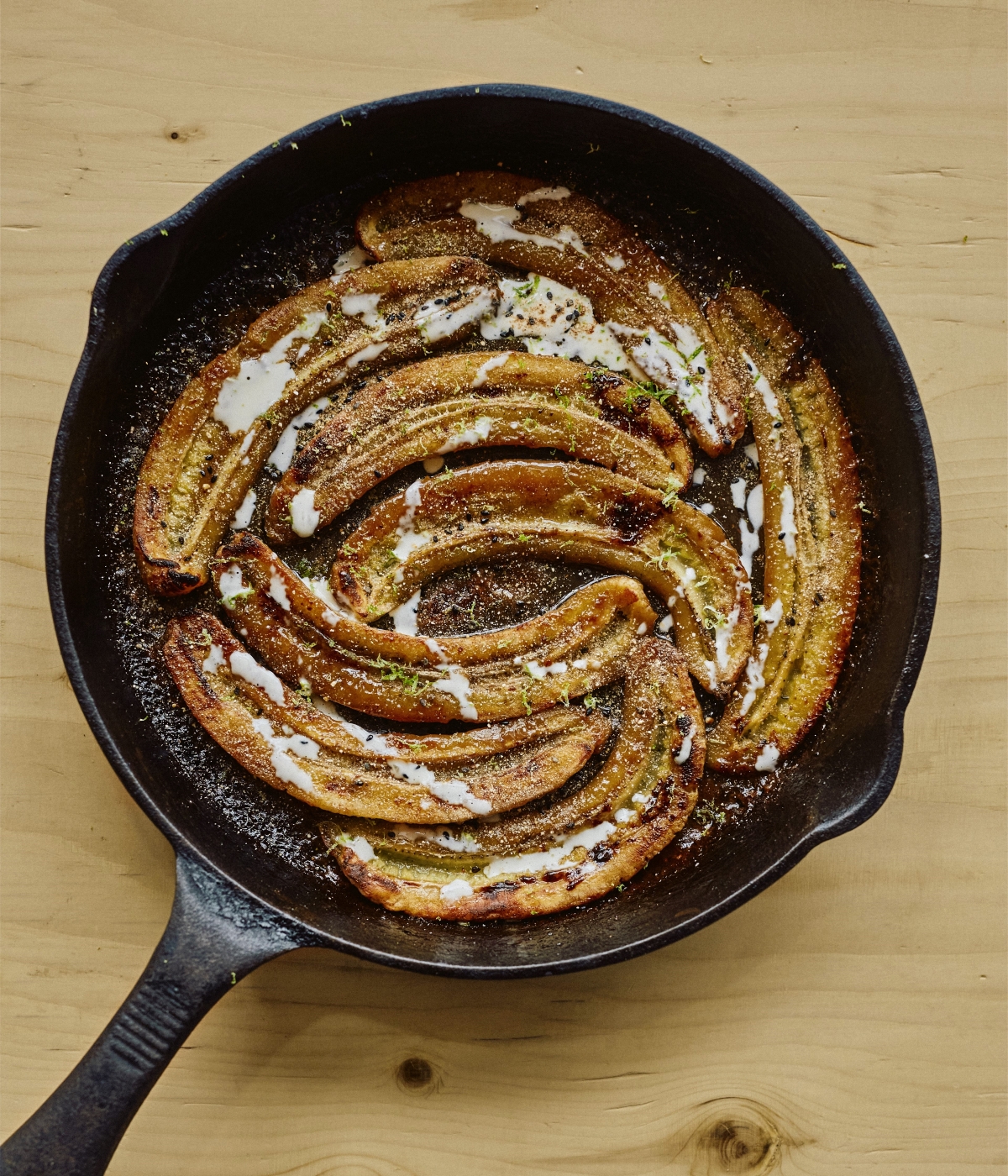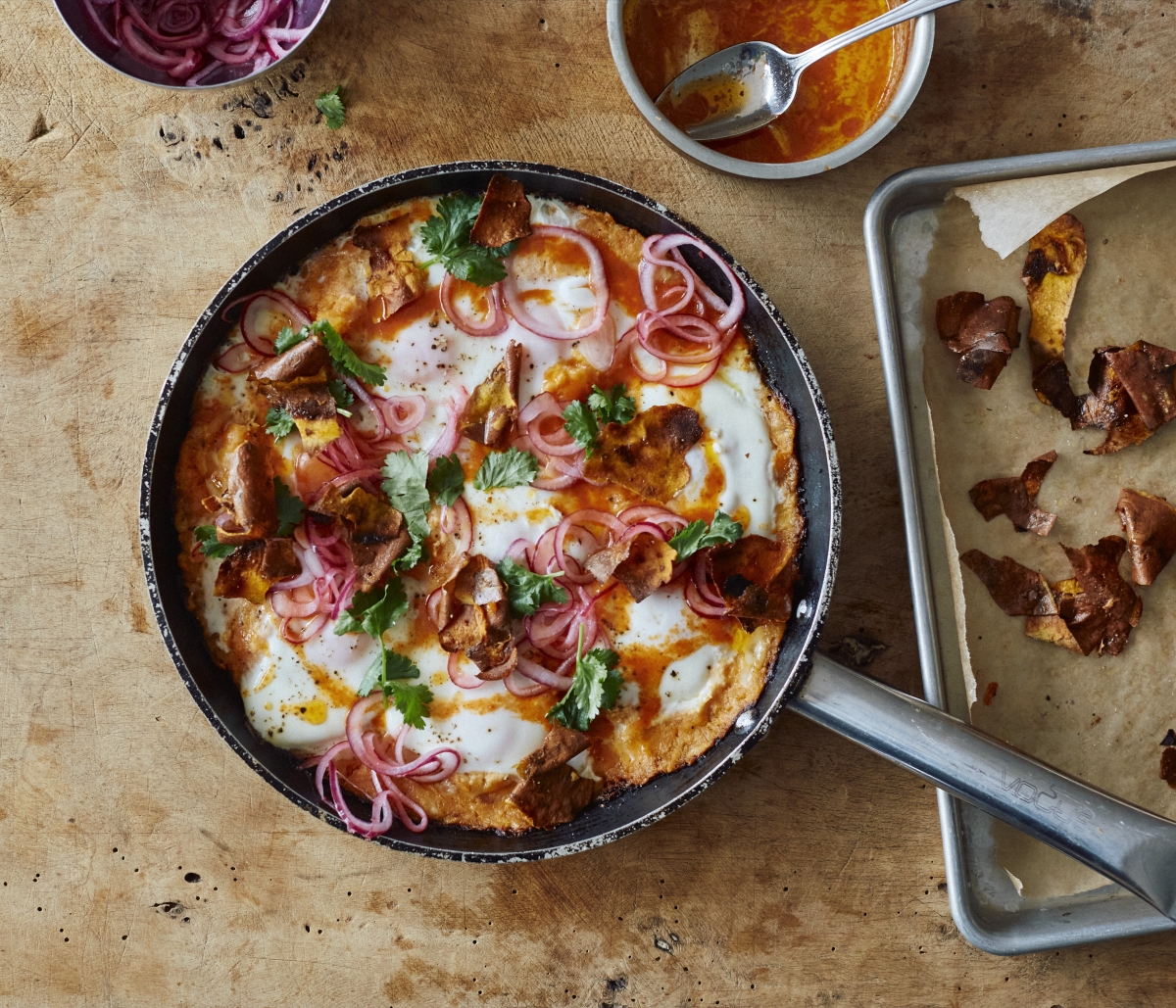
Yotam Ottolenghi and his team at the Ottolenghi Test Kitchen bring
you flexible, stress-free home cooking. With an 'Ottolenghi' twist,
they transform everyday ingredients into creative, approachable
dishes. In sync with our times, the book is all about using what's
already in your kitchen — whether it's a can of chickpeas or a bag
of frozen peas — to make delicious meals without extra shopping
trips. Featuring recipes like creamy hummus, confit tandoori
chickpeas, and the ultimate tomato salad, this book encourages
you to make each dish your own. Discover the joy of cooking,
the OTK way.
INDEX
Curried cauliflower cheese filo pie
Sticky miso bananas with lime and toasted rice
“This dessert ticks all our flavour boxes – sweet, salty, tangy and umami – and all our texture boxes – sticky, crunchy and
creamy. The bananas you use should have almost completely yellow skin, with only the tiniest bit of brown spotting.”
 Serves 4
Serves 4
Prep time: 5 minutes
Cook time: 30 minutes
40g unsalted butter
70g light soft brown sugar
½ tsp ground star anise
3 tbsp creme fraiche
1½ tbsp white miso
4 medium bananas (medium ripe), peeled and halved lengthways
1 lime: finely grate the zest to get 1 tsp and then juice to get 1½ tsp
TOASTED RICE TOPPING
1 tbsp Thai sticky rice (raw), or jasmine rice
2 tsp black sesame seeds
½ tsp ground star anise
1. Set the oven to its highest grill setting.
2. Make the topping. Toast the rice in a small frying pan on a medium heat for 12–15 minutes,
shaking the pan from time to time, until deeply golden. Blitz in a spice or coffee grinder until
fine, then transfer to a small bowl. Return the pan to a medium-high heat and add the sesame seeds.
Toast for 1 minute, then stir into the rice bowl along with the star anise. Set aside.
3. Put the butter, sugar, star anise and half the creme fraiche into a large, ovenproof cast-iron pan (or a large saute pan) on a medium heat. Stir the mixture frequently, until the butter has melted and
the sugar has dissolved, then, off the heat, whisk in the miso until smooth. Add the bananas, cut side up, using a spoon to coat the tops with some of the caramel, then transfer to the oven and grill for about 8 minutes (this will vary, depending on your grill, so check them at the 7-minute mark), or
until the bananas have softened and are lightly browned.
4. While the bananas are grilling, mix the remaining creme fraiche with the lime juice. When ready, spoon this all over the bananas, then sprinkle with the lime zest and a tablespoon of the rice topping. Serve immediately and directly from the pan, with the extra rice topping alongside.
Sweet Potato Shakshuka
with sriracha butter and pickled onions
“A far cry from a classic shakshuka, yes, but we’ve found that sweet potatoes provide just the right amount of moisture
and heft to serve as a base for these eggs. Serve this vibrant dish as a weekend brunch; it sure looks the part.”
 Serves: 4
Serves: 4
Prep time: 20 minutes
Cook time: 1 hour 20 minutes
1kg sweet potatoes, skin on and scrubbed clean
1 small red onion, thinly sliced into rounds (100g)
2 tbsp lemon juice
3 tbsp olive oil
150g mature cheddar, roughly grated
3 garlic cloves, crushed
1 tsp cumin seeds, roughly crushed with a pestle and mortar
8 medium eggs
25g unsalted butter
¾ tbsp sriracha
2 tbsp picked fresh coriander leaves, with some stem attached
salt and black pepper
Preheat the oven to 200°C fan. Poke the sweet potatoes all over with a fork (about 8–10 times) and place them on a medium, parchment-lined baking tray. Bake for 45–50 minutes, or until cooked through and softened. Set aside to cool and turn the oven temperature down to 180°C fan. Meanwhile, in a small bowl mix together the onion, 1 tablespoon of lemon juice and a pinch of salt and set aside to pickle.
Remove the cooked potato skins and tear them into roughly 4cm pieces. Transfer the potato flesh to a large bowl and set aside. Place the skins back on the baking tray and toss with 1 tablespoon of oil, ¼ teaspoon of salt and a good grind of pepper. Bake for 8 minutes, or until nicely coloured and starting to crisp up. Set aside to cool and crisp up further.
Use a fork to mash the potato flesh until smooth, then add the cheddar, garlic, cumin, another tablespoon of oil, the remaining tablespoon of lemon juice, 1 teaspoon of salt and a generous grind of pepper, and mix to combine.
Put the remaining tablespoon of oil into a large frying pan, for which you have a lid, and swirl around to coat the bottom. Spoon the mashed potato mixture into the pan, using your spoon to distribute it evenly. Place on a medium-high heat and leave to cook for about 7 minutes, for the bottom to start to colour. Turn the heat down to medium and use a spoon to make eight wells in the potato mixture, breaking an egg into each. Sprinkle lightly with salt and pepper, cover with the lid and cook for 4–5 minutes, rotating the pan, or until the whites are set and the yolks are still runny.
While the eggs are cooking, put the butter and sriracha into a small saucepan on a medium heat and cook until the butter has melted, whisking constantly to emulsify. Remove the mixture from the heat before it starts to bubble – you don’t want it to split.
When ready, spoon the sriracha butter all over the eggs, then top with a good handful of the crispy potato skins, half the pickled onion and all the picked coriander leaves. Serve right away, with the rest of the potato skins and pickled onion to eat alongside.
Curried cauliflower cheese filo pie
"Cauliflower cheese, but make it pie. This dish was once described as ‘molten-hot-cheese-lava’
and we think that’s pretty fitting for the ultimate comfort of comfort foods."
Serves 4, generously
Prep time: 20 minutes
Cook time: 1 hour 45 minutes
1 large cauliflower, trimmed and cut into bite-size florets (700g)
2 tsp mild curry powder
3 tbsp olive oil
100g unsalted butter, 50g cut into roughly 3cm cubes and 50g melted
75g plain flour
675ml whole milk
2 garlic cloves, crushed
1 ½ tbsp English mustard
150g mature cheddar, roughly grated
6 sheets of good-quality filo pastry
salt and black pepper
1 tbsp roughly chopped parsley, to serve
1 ½ tsp lemon zest, to serve
1. Preheat the oven to 180°C fan. Line the bottom and sides of a 23cm springform cake tin with baking parchment.
2. Put the cauliflower on a large, parchment-lined baking tray and toss with the curry powder, half the oil, ½ teaspoon of salt and a good grind of pepper. Roast for about 20 minutes, until cooked through and lightly coloured. Set aside, and turn the oven temperature down to 170°C fan.
3. Meanwhile, make the bechamel. Put the cubed butter into a medium saucepan on a medium-high heat and, once melted, whisk in the flour and cook for 1–2 minutes – it should start to smell nutty (like popcorn). Turn the heat down to medium and slowly add the milk a little at a time, whisking continuously to prevent any lumps, until incorporated and the sauce is smooth. Cook, whisking often, for about 7 minutes, until thickened slightly. Off the heat, stir in the garlic, mustard, cheese and ¼ teaspoon of salt until the cheese has melted.
4. Keep your filo sheets under a damp tea towel to prevent them from drying out. In a bowl, combine the melted butter and the remaining 1½ tablespoons of oil and keep to one side.
5. Working one sheet at a time, brush the exposed side of the filo with the butter mixture and drape it into your prepared tin (buttered side up), pushing it down gently to fit. Continue in this way with the next filo sheet, brushing it with butter and then laying it over the bottom sheet, rotating it slightly so the overhang drapes over the sides at a different angle. Do this with all six sheets.
6. Spoon half the bechamel into the base and top with the roasted cauliflower florets. Spoon over the remaining bechamel, then crimp up the overhang so that it creates a messy ‘scrunched-up’ border around the edges, leaving the centre of the pie exposed.
7. Brush the top of the filo border with the remaining butter mixture, then transfer the tin to a baking tray and bake for 30 minutes.
8. Using a tea towel to help you, carefully release the outer circle of the springform tin and return the pie to the oven for another 20–25 minutes, or until the sides are nicely coloured and everything is golden and bubbling. Leave to settle for 15 minutes.
9. Top the pie with the parsley and lemon zest and serve warm.
with pickled jalapeños
"These impressive-looking peppers are deceptively easy to put together, and a sure way to put that bag of frozen
sweetcorn to good use. Eat this alongside a fresh salad or some roasted potatoes, for a complete meal."
Serves 4, as a light lunch
Prep time: 20 minutes
Cook time: 1 hour 15 minutes
1 green jalapeño, thinly sliced, seeds and all (15g)
2 tbsp apple cider vinegar
1 tsp caster sugar
250g frozen sweetcorn kernels, defrosted
100ml double cream
50g quick-cook polenta
3 garlic cloves, crushed
1 egg
105ml olive oil
75g low-moisture mozzarella, roughly grated
75g mature cheddar, roughly grated
4 medium red romano peppers
2 onions, cut into 5 x 1cm rounds
5g thyme sprigs
10g fresh coriander, finely chopped
salt and black pepper
1. Preheat the oven to 180°C fan.
2. Put the jalapeño, vinegar and sugar into a small bowl and mix to combine. Set aside to pickle.
3. Put the sweetcorn, cream, polenta, two-thirds of the garlic, the egg, 1 tablespoon of oil, ¾ teaspoon of salt and a generous grind of pepper into a food processor and pulse to a very rough purée. Transfer to a bowl and stir through the cheeses.
4. Use a small, sharp knife to make an incision lengthways into each romano pepper (making sure not to cut through the ends), keeping the stem intact. Gently use your fingers to remove and discard the seeds, then stuff each pepper with the sweetcorn mixture.
5. Put 1 tablespoon of oil in the base of a large, cast-iron saucepan or sauté pan and then top with the onion rounds and thyme to cover the base, sprinkling with a little salt and pepper. Place the peppers, slit side up, on top of the onions and drizzle them with 1 tablespoon of oil. Season lightly with salt and pepper, then pour 200ml of water into the pan, making sure not to pour it on top of the peppers. Bake for 30 minutes, then turn the heat up to 200°C fan and bake for another 20 minutes, or until everything is soft and nicely coloured.
6. Meanwhile, put the remaining 4 tablespoons of oil, the coriander, the remaining garlic, ⅛ teaspoon of salt and a good grind of pepper into a small bowl and stir to combine.
7. Spoon the coriander oil and pickled jalapeños over the peppers and serve warm.
Make it your own:
– Use regular red peppers if you can’t find romano.
– Play with your cheeses – anything oozy and melty will work here!
– Double this recipe if cooking for a larger crowd.
and tahini
"If you haven’t yet paired fish with tahini, then you’re in for a real treat. This version combines tahini with herbaceous za’atar and sour sumac, our ever familiar but much treasured test kitchen staples. We strongly recommend using creamy, nutty tahini that’s sourced from countries within the Levant. Eat this shortly after cooking, as cooked tahini doesn’t sit or reheat very well."
Serves 4
Prep time: 5 minutes
Cook time: 20 minutes
4 salmon fillets (600g), skin on and pin bones removed
2 tbsp za’atar
2 tsp sumac, plus ½ tsp extra for sprinkling
60ml olive oil
250g baby spinach
90g tahini
3 garlic cloves, crushed
3½ tbsp lemon juice
1½ tbsp roughly chopped coriander leaves
salt and black pepper
1. Preheat the oven to 220°C fan.
2. Pat dry the salmon and sprinkle with salt and pepper. In a small bowl, combine the za’atar and sumac, then sprinkle this all over the top of the salmon to create a crust.
3. Place a large ovenproof sauté pan on a medium-high heat and add a tablespoon of oil. Once hot, add the spinach and a pinch each of salt and pepper and cook for 2–3 minutes, until just wilted.
4. Top with the salmon, skin side down, and drizzle the top of the fish with 2 tablespoons of oil. Bake for 5 minutes.
5. Meanwhile, in a small bowl whisk together the tahini, garlic, 2½ tablespoons of lemon juice, a good pinch of salt and 100ml of water until smooth and quite runny.
6. When ready, remove the pan from the oven and pour the tahini all around the salmon (but not on the fish at all). Bake for another 5 minutes, or until the fish is cooked through and the tahini is bubbling. Spoon over the remaining tablespoon each of lemon juice and oil and top with the coriander and extra sumac.
Make it your own:
– Swap out the salmon for other sustainably caught fish, adjusting cooking times where needed.
– Use other leafy greens in place of spinach, such as kale or chard.
Extracted from Ottolenghi Test Kitchen: Shelf Love by Noor Murad and Yotam Ottolenghi
All photography by Elena Heatherwick
____________________________________________________________________________________________________________________________
 |
 |
|
YOU MAY ALSO ENJOY
Recipes: Flavour by Ixta Belfrage and Yotam Ottolenghi







